Daviesia pseudaphylla, commonly known as Stirling Range daviesia, is a species of flowering plant in the family Fabaceae and is endemic to the Stirling Range in the south-west of Western Australia. It is an open, spreading, glabrous shrub with low-lying stems, scattered, cylindrical phyllodes indistinguishable from branchlets, and orange-yellow and dark reddish flowers.

Daviesia abnormis is a species of flowering plant in the family Fabaceae and is endemic to the south-west of Western Australia. It is an erect, hairy shrub with sharply-pointed, narrow elliptic to narrow egg-shaped phyllodes with the narrower end towards the base, and yellow flowers with faint red markings.
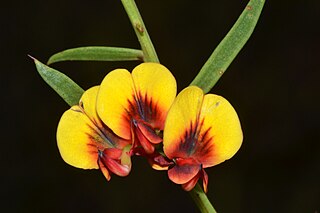
Daviesia angulata is a species of flowering plant in the family Fabaceae and is endemic to the south-west of Western Australia. It is an erect, spreading shrub with prickly, flattened phyllodes, and yellow flowers with red markings.

Daviesia cardiophylla is a species of flowering plant in the family Fabaceae and is endemic to the southwest of Western Australia. It is an erect, spreading shrub with heart-shaped, sharply pointed phyllodes and yellow and red flowers.

Daviesia crassa is a species of flowering plant in the family Fabaceae and is endemic to the south-west of Western Australia. It is a compact, dense, glabrous shrub with densely crowded, thick, club-shaped phyllodes, and uniformly yellow flowers.

Daviesia daphnoides is a species of flowering plant in the family Fabaceae and is endemic to the south-west of Western Australia. It is a bushy or spreading shrub with glabrous foliage, sharply-pointed narrow elliptic to egg-shaped phyllodes with the narrower end towards the base and yellow and dark red flowers.

Daviesia decipiens is a species of flowering plant in the family Fabaceae and is endemic to the south-west of Western Australia. It is an intricately-branched shrub with scattered, sharply-pointed oblong or tapering phyllodes, and orange, maroon and crimson flowers.

Daviesia dielsii, commonly known as Diels' daviesia, is a species of flowering plant in the family Fabaceae and is endemic to the south-west of Western Australia. It is on intricately-branched shrub with sharply-pointed, egg-shaped, vertically compressed phyllodes, and yellow and red flowers.

Daviesia aphylla is a species of flowering plant in the family Fabaceae and is endemic to the south-west of Western Australia. It is an erect, bushy shrub with glabrous foliage, up to six sharply-pointed phyllodes on each branchlet, and orange-red and yellow flowers.
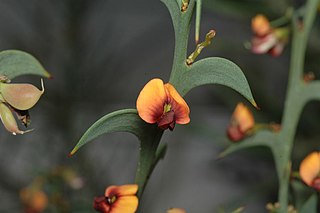
Daviesia dilatata is a species of flowering plant in the family Fabaceae and is endemic to the south-west of Western Australia. It is an erect, open, glabrous shrub with scattered, often sickle-shaped phyllodes, and orange, red, yellow and dark crimson flowers.

Daviesia discolor is a species of flowering plant in the family Fabaceae and is endemic to Queensland. It is a glabrous, multi-stemmed shrub with linear, more or less sickle-shaped phyllodes, and yellow and dark red flowers.

Daviesia elliptica, commonly known as wild hops, is a species of flowering plant in the family Fabaceae and is endemic to eastern Australia. It is an open, usually multi-stemmed shrub with scattered, narrowly elliptic to egg-shaped phyllodes, and yellow and red to maroon flowers.

Daviesia elongata is a species of flowering plant in the family Fabaceae and is endemic to the south-west of Western Australia. It is a glabrous, spreading or sprawling shrub with narrowly egg-shaped to linear phyllodes and yellow-orange and maroon flowers.

Daviesia emarginata is a species of flowering plant in the family Fabaceae and is endemic to the south-west of Western Australia. It is an erect, mostly glabrous shrub with scattered egg-shaped phyllodes with the narrower end towards the base and with a notch at the tip, and yellow and pink flowers.
Daviesia eremaea is a species of flowering plant in the family Fabaceae and is endemic to central Australia. It is an erect, glabrous, multi-stemmed shrub with needle-like, more or less sharply-pointed phyllodes, and yellow and red flowers.
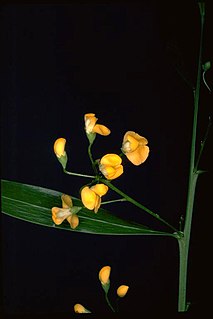
Daviesia flava is a species of flowering plant in the family Fabaceae and is endemic to Queensland. It is a glabrous shrub with linear or narrowly egg-shaped phyllodes, and uniformly yellow flowers.
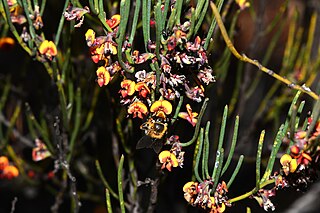
Daviesia nematophylla is a species of flowering plant in the family Fabaceae and is endemic to the south-west of Western Australia. It is a dense, erect shrub with glabrous foliage, erect, usually needle-shaped phyllodes, and yellow, orange and dark red flowers.
Daviesia pachyloma is a species of flowering plant in the family Fabaceae and is endemic to the south-west of Western Australia. It is an erect, bushy or spreading shrub with zigzagging branches, sharply-pointed, narrowly elliptic to linear phyllodes, and yellow and red flowers.

Daviesia pachyphylla, commonly known a ouch bush, is a species of flowering plant in the family Fabaceae and is endemic to the south of Western Australia. It is usually a slender shrub with often arching branchlets, crowded, sharply-pointed, narrowly conical phyllodes, and yellow to orange and dark reddish-brown flowers.
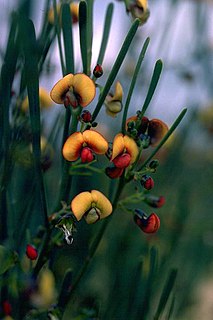
Daviesia rubiginosa is a species of flowering plant in the family Fabaceae and is endemic to inland areas of south-western Western Australia. It is a broom-like, glabrous to glaucous shrub with scattered, linear to cylindrical phyllodes, and orange-yellow and red flowers.
















